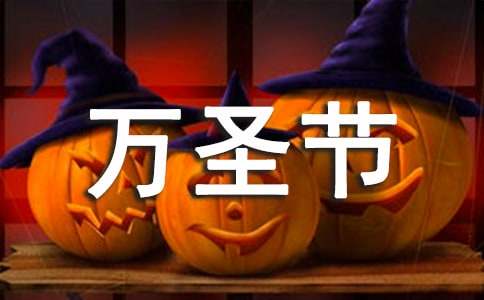- 相关推荐
万圣节简介英文
下面小编给大家准备了有关万圣节的英文简介,有兴趣的朋友可以阅读了解一下哦!

【万圣节简介英文】
As European immigrants came to America, they brought their varied Halloween customs with them. Because of the rigid Protestant belief systems that characterized early New England, celebration of Halloween in colonial times was extremely limited there.
It was much more common in Maryland and the southern colonies. As the beliefs and customs of different European ethnic groups, as well as the American Indians, meshed, a distinctly American version of Halloween began to emerge.
The first celebrations included "play parties," public events held to celebrate the harvest, where neighbors would share stories of the dead, tell each other's fortunes, dance, and sing.
Colonial Halloween festivities also featured the telling of ghost stories and mischief-making of all kinds. By the middle of the nineteenth century, annual autumn festivities were common, but Halloween was not yet celebrated everywhere in the country.
In the second half of the nineteenth century, America was flooded with new immigrants. These new immigrants, especially the millions of Irish fleeing Ireland's potato famine of 1846, helped to popularize the celebration of Halloween nationally.
Taking from Irish and English traditions, Americans began to dress up in costumes and go house to house asking for food or money, a practice that eventually became today's "trick-or-treat" tradition.
Young women believed that, on Halloween, they could divine the name or appearance of their future husband by doing tricks with yarn, apple parings, or mirrors.
In the late 1800s, there was a move in America to mold Halloween into a holiday more about community and neighborly get-togethers, than about ghosts, pranks, and witchcraft.
At the turn of the century, Halloween parties for both children and adults became the most common way to celebrate the day.
Parties focused on games, foods of the season, and festive costumes. Parents were encouraged by newspapers and community leaders to take anything "frightening" or "grotesque" out of Halloween celebrations. Because of their efforts, Halloween lost most of its superstitious and religious overtones by the beginning of the twentieth century.
By the 1920s and 1930s, Halloween had become a secular, but community-centered holiday, with parades and town-wide parties as the featured entertainment. Despite the best efforts of many schools and communities, vandalism began to plague Halloween celebrations in many communities during this time.
By the 1950s, town leaders had successfully limited vandalism and Halloween had evolved into a holiday directed mainly at the young. Due to the high numbers of young children during the fifties baby boom, parties moved from town civic centers into the classroom or home, where they could be more easily accommodated.
Between 1920 and 1950, the centuries-old practice of trick-or-treating was also revived. Trick-or-treating was a relatively inexpensive way for an entire community to share the Halloween celebration. In theory, families could also prevent tricks being played on them by providing the neighborhood children with small treats.
A new American tradition was born, and it has continued to grow. Today, Americans spend an estimated $6.9 billion annually on Halloween, making it the country's second largest commercial holiday.
【万圣节服装由来】
万圣节的服装起源于恶作剧,大人带孩子一起出门(一般是大人驾车停在路边,小孩说:“不给糖,就捣蛋(trick or treat)的游戏。大人事先要求孩子只许去门口有节日布置的并点了灯的人家,否则不许打扰。
另外讨糖过程中必须始终站在大门口等待,不许进屋,讨回的`糖也要交给大人检查后才许吃。对接待孩子的人家也要求不给自家制作的食品,也不给未包装的食品。
万圣节的服装,万人万相,不只是单调的大鬼小鬼。制作最简单的鬼服就用一张白床单顶在头上,抠两个洞留出眼睛;若要扮演魔术师,就穿上黑衣黑裤,再戴上黑礼帽,并在礼帽与头顶之间藏一只绒毛小兔备用;小孩穿上白衣白裤,再在背后绑一个手电筒在头上就打扮成了小天使;也有家长把孩子打扮成他们喜欢的卡通形象的。
【万圣节南瓜灯由来】
南瓜灯源于古代爱尔兰。传说一个名叫JACK(杰克)的人,是个醉汉且爱恶作剧。一天JACK把恶魔骗上了树,随即在树桩上刻了个十字,恐吓恶魔令他不敢下来,然后JACK就与恶魔约法三章,让恶魔答应施法让JACK永远不会犯罪为条件让他下树。
JACK死后,其灵魂却既不能上天堂又不能下地狱,于是他的.亡灵只好靠一根小蜡烛照着指引他在天地之间倘佯。
在古老的爱尔兰传说里,这根小蜡烛是在一根挖空的萝卜里放着,称作“JACK LANTERNS”,而古老的萝卜灯演变到今天,则是南瓜做的Jack-O-Lantern了。
据说爱尔兰人到了美国不久,即发现南瓜不论从来源和雕刻来说都比萝卜更胜一筹,于是南瓜就成了万圣节的宠儿。
【万圣节简介英文】相关文章:
元旦节英文简介07-31
万圣节的习俗英文11-01
万圣节介绍英文简短07-19
万圣节的英文儿歌歌词06-22
万圣节的意义英文(通用10篇)09-07
万圣节英文手抄报内容07-17
万圣节快乐英文祝福语06-16
IBM简介08-11
WAP的简介10-03
SOAP简介08-15